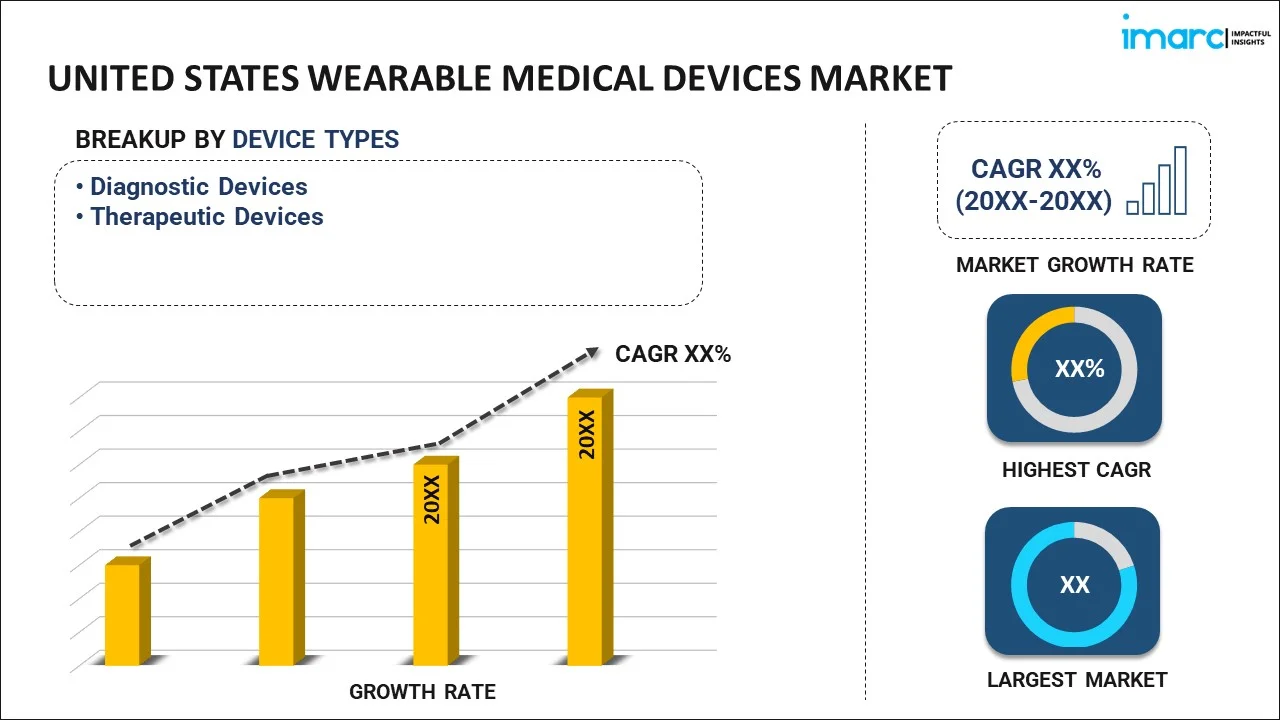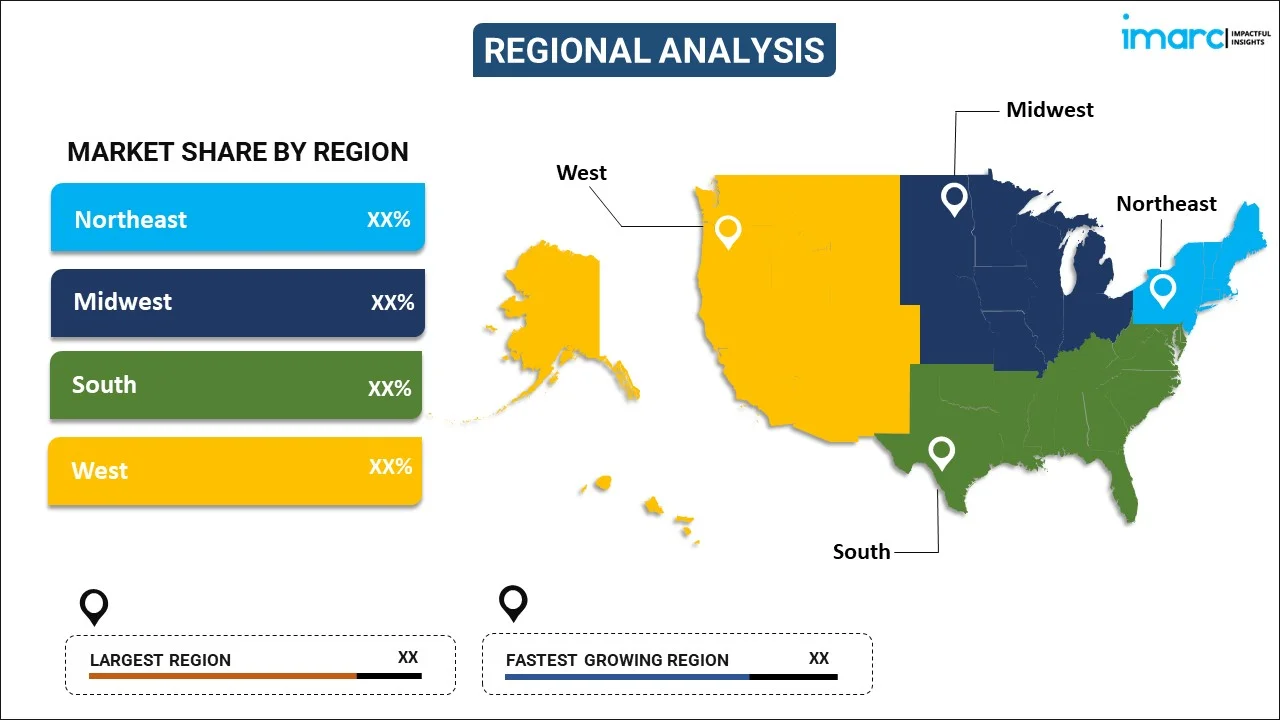
United States Wearable Medical Devices Market Report by Device Type (Diagnostic Devices, Therapeutic Devices), Product (Activity Monitors, Smartwatches, Patches, Smart Clothing, Hearing Aids, and Others), Distribution Channel (Offline, Online), Application (Sports and Fitness, Remote Patient Monitoring, Home Healthcare), and Region 2024-2032
Market Overview:
United States wearable medical devices market size is projected to exhibit a growth rate (CAGR) of 25.60% during 2024-2032. The rising prevalence of chronic diseases, such as diabetes, cardiovascular disorders, and obesity, the expanding aging population, and rapid advancements in sensor technology, miniaturization, and data analytics represent some of the key factors driving the market.
|
Report Attribute
|
Key Statistics
|
|---|---|
|
Base Year
|
2023 |
|
Forecast Years
|
2024-2032 |
|
Historical Years
|
2018-2023
|
| Market Growth Rate (2024-2032) | 25.60% |
Wearable medical devices refer to portable, non-invasive technologies designed to monitor, collect, and transmit health-related data in real-time. These devices are typically worn on the body, providing continuous or on-demand insights into the vital signs, physical activity, and other health parameters of an individual. They are lightweight, discreet, and comfortable to wear, ensuring minimal disruption to the daily life of users. They incorporate various sensors, such as heart rate monitors, accelerometers, and temperature sensors, to capture physiological data. They are equipped with Bluetooth or other wireless technologies, enabling seamless data transmission to smartphones or cloud platforms. They aid in managing chronic conditions like diabetes, hypertension, and sleep disorders by offering actionable insights and medication reminders. They promote a proactive approach to health, helping users adopt healthier lifestyles and reduce the risk of future health problems. They enable healthcare professionals to remotely monitor patients, adjust treatment plans as needed, and provide timely interventions. Besides this, as they can enhance the safety and well-being of the elderly by monitoring falls, detecting irregularities, and sending alerts to caregivers, the demand for wearable medical devices is increasing in the United States.
United States Wearable Medical Devices Market Trends:
The rising prevalence of chronic diseases, such as diabetes, cardiovascular disorders, and obesity, represents one of the primary factors driving the demand for wearable medical devices in the United States. Additionally, the expanding aging population in the country is catalyzing the demand for healthcare solutions like wearable medical devices. Apart from this, rapid advancements in sensor technology, miniaturization, and data analytics are enhancing the capabilities of wearable medical devices. Along with this, the integration of artificial intelligence (AI) and machine learning algorithms is enabling predictive analytics and actionable insights, making these devices more valuable for patients and healthcare professionals. Furthermore, the growing awareness among the masses in the United States about the importance of proactive healthcare and wellness is offering a favorable market outlook. Moreover, the widespread adoption of telehealth and remote monitoring solutions is strengthening the growth of the market. Furthermore, various regulatory agencies, such as the U.S. Food and Drug Administration (FDA) and the European Medicines Agency (EMA), are implementing guidelines and standards for wearable medical devices. Compliance with these standards ensures the safety and efficacy of these devices, further driving their adoption. In line with this, the increasing collaborations between technology companies, healthcare providers, and pharmaceutical companies are influencing the market positively. These partnerships leverage the strengths of each sector to develop innovative wearable medical solutions. Besides this, the leading market players are diversifying their product portfolios to cater to the diverse needs of different regions.
United States Wearable Medical Devices Market Segmentation:
IMARC Group provides an analysis of the key trends in each segment of the market, along with forecasts at the country level for 2024-2032. Our report has categorized the market based on device type, product, distribution channel, and application.
Device Type Insights:

- Diagnostic Devices
- Vital Sign Monitoring Devices
- Sleep Monitoring Devices
- Electrocardiographs and Obstetric Devices
- Neuromonitoring Devices
- Therapeutic Devices
- Pain Management Devices
- Insulin Delivery Devices
- Rehabilitation Devices
- Respiratory Therapy Devices
The report has provided a detailed breakup and analysis of the market based on the device type. This includes diagnostic devices (vital sign monitoring devices, sleep monitoring devices, electrocardiographs and obstetric devices, and neuromonitoring devices) and therapeutic devices (pain management devices, insulin delivery devices, rehabilitation devices, and respiratory therapy devices).
Product Insights:
- Activity Monitors
- Smartwatches
- Patches
- Smart Clothing
- Hearing Aids
- Others
A detailed breakup and analysis of the market based on the product have also been provided in the report. This includes activity monitors, smartwatches, patches, smart clothing, hearing aids, and others.
Distribution Channel Insights:
- Offline
- Online
The report has provided a detailed breakup and analysis of the market based on the distribution channel. This includes offline and online.
Application Insights:
- Sports and Fitness
- Remote Patient Monitoring
- Home Healthcare
A detailed breakup and analysis of the market based on the application have also been provided in the report. This includes sports and fitness, remote patient monitoring, and home healthcare.
Regional Insights:

- Northeast
- Midwest
- South
- West
The report has also provided a comprehensive analysis of all the major regional markets, which include Northeast, Midwest, South, and West.
Competitive Landscape:
The market research report has also provided a comprehensive analysis of the competitive landscape in the market. Competitive analysis such as market structure, key player positioning, top winning strategies, competitive dashboard, and company evaluation quadrant has been covered in the report. Also, detailed profiles of all major companies have been provided.
United States Wearable Medical Devices Market Report Coverage:
| Report Features | Details |
|---|---|
| Base Year of the Analysis | 2023 |
| Historical Period | 2018-2023 |
| Forecast Period | 2024-2032 |
| Units | US$ Million |
| Scope of the Report | Exploration of Historical Trends and Market Outlook, Industry Catalysts and Challenges, Segment-Wise Historical and Future Market Assessment:
|
| Device Types Covered |
|
| Products Covered | Activity Monitors, Smartwatches, Patches, Smart Clothing, Hearing Aids, Others |
| Distribution Channels Covered | Offline, Online |
| Applications Covered | Sports and Fitness, Remote Patient Monitoring, Home Healthcare |
| Regions Covered | Northeast, Midwest, South, West |
| Customization Scope | 10% Free Customization |
| Report Price and Purchase Option | Single User License: US$ 3699 Five User License: US$ 4699 Corporate License: US$ 5699 |
| Post-Sale Analyst Support | 10-12 Weeks |
| Delivery Format | PDF and Excel through Email (We can also provide the editable version of the report in PPT/Word format on special request) |
Key Questions Answered in This Report:
- How has the United States wearable medical devices market performed so far and how will it perform in the coming years?
- What has been the impact of COVID-19 on the United States wearable medical devices market?
- What is the breakup of the United States wearable medical devices market on the basis of device type?
- What is the breakup of the United States wearable medical devices market on the basis of product?
- What is the breakup of the United States wearable medical devices market on the basis of distribution channel?
- What is the breakup of the United States wearable medical devices market on the basis of application?
- What are the various stages in the value chain of the United States wearable medical devices market?
- What are the key driving factors and challenges in the United States wearable medical devices?
- What is the structure of the United States wearable medical devices market and who are the key players?
- What is the degree of competition in the United States wearable medical devices market?
Key Benefits for Stakeholders:
- IMARC’s industry report offers a comprehensive quantitative analysis of various market segments, historical and current market trends, market forecasts, and dynamics of the United States wearable medical devices market from 2018-2032.
- The research report provides the latest information on the market drivers, challenges, and opportunities in the United States wearable medical devices market.
- Porter's five forces analysis assist stakeholders in assessing the impact of new entrants, competitive rivalry, supplier power, buyer power, and the threat of substitution. It helps stakeholders to analyze the level of competition within the United States wearable medical devices industry and its attractiveness.
- Competitive landscape allows stakeholders to understand their competitive environment and provides an insight into the current positions of key players in the market.
Need more help?
- Speak to our experienced analysts for insights on the current market scenarios.
- Include additional segments and countries to customize the report as per your requirement.
- Gain an unparalleled competitive advantage in your domain by understanding how to utilize the report and positively impacting your operations and revenue.
- For further assistance, please connect with our analysts.
 Inquire Before Buying
Inquire Before Buying
 Speak to an Analyst
Speak to an Analyst
 Request Brochure
Request Brochure
 Request Customization
Request Customization




.webp)




.webp)












